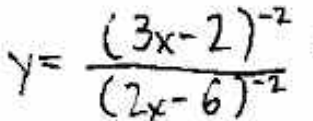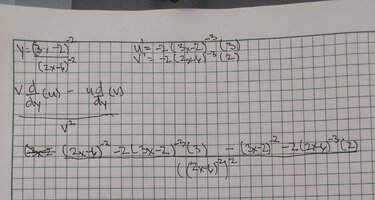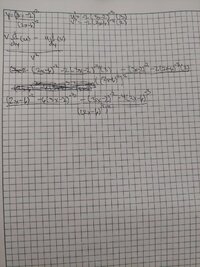You are using an out of date browser. It may not display this or other websites correctly.
You should upgrade or use an alternative browser.
You should upgrade or use an alternative browser.
Find derivative of y = [ (3x - 2)^{-2} ] / [ (2x - 6)^{-2} ] using Quotient Rule, Chain Rule
- Thread starter ADG420
- Start date
- Joined
- Feb 4, 2004
- Messages
- 16,582
Could someone help me find this derivative using (1) the Quotient Rule and (2) the Chain Rule?
[imath]\qquad y = \dfrac{(3x - 2)^{-2}}{(2x - 6)^{-2}}[/imath]
We'll be glad to help! But first we'll need to see what you've tried and how far you've gotten.
Thank you!
First, the problem formulation itself gives you a hint. You are to use the chain rule. That suggests a substirution. Of course it does not sugesst which substitution. Selecting USEFUL substitutions is an art that you develop with experience.
Second, I shall give a hint on a helpful substitution.
[math]\text {Let } p = (3x - 2)^2 \text { and } q = (2x - 6)^2.[/math]
Second, I shall give a hint on a helpful substitution.
[math]\text {Let } p = (3x - 2)^2 \text { and } q = (2x - 6)^2.[/math]
Dr.Peterson
Elite Member
- Joined
- Nov 12, 2017
- Messages
- 16,619
Apply the fact that [imath](a^m)^n=a^{mn}[/imath].What do I do with ((2x-6)^-2)^2?
You're referring to this:This is where I left off. I can't proceed because I don't know how to multiply v*u' and u*v'.
First, you need to correct it, because these are multiplications, not subtractions:
Then I would factor out the lowest power of each base, namely [imath](2x-6)^{-3}(2x-2)^{-3}[/imath]. Or, if you prefer, multiply the numerator and denominator by [imath](2x-6)^{3}(2x-2)^{3}[/imath] to eliminate the negative powers.
I often observe that calculus is where you finally learn algebra, because you have to use it as a tool. All of this is things you are expected to know already, but weren't forced to really master.
You clearly read my post #4 because you thanked me for it, and you're welcome.First, the problem formulation itself gives you a hint. You are to use the chain rule. That suggests a substirution. Of course it does not sugesst which substitution. Selecting USEFUL substitutions is an art that you develop with experience.
Second, I shall give a hint on a helpful substitution.
[math]\text {Let } p = (3x - 2)^2 \text { and } q = (2x - 6)^2.[/math]
But you did not use it.
Substitution is NEVER necessary in differential calculus, but it is frequently very useful.
[math]\text {Let } p = (3x - 2)^2 \text { and } q = (2x - 6)^2 \implies\\ p'= 2(3x - 2)(3) = 6p \text { and } q' = 2(2x - 6)(2) = 4q.\\ \text {Given: } y = \dfrac{(3x - 2)^{-2}}{(2x - 6)^{-2}} = \dfrac{p^{-1}}{q^{-1}} = \dfrac{q}{p}.\\ \therefore \ y' = \dfrac{qp' - q'p}{p^2} = \dfrac{q(6p) - 4qp}{p^2} = \dfrac{6q - 4q}{p} = \dfrac{2q}{p} = \text {WHAT?}[/math]
Now I completely agree with Dr. Peterson that many people learn algebra by studying calculus. I did for one. But the substitution I suggested is one way to make the algebra far less error prone. It is a bit more time consuming, but you will make fewer errors.
Steven G
Elite Member
- Joined
- Dec 30, 2014
- Messages
- 14,561
If you don't know/remember, then you go back to the definitions...What do I do with ((2x-6)^-2)^2?
Consider (x2)3= (x2)(x2)(x2)=(xx)(xx)(xx) = xxxxxx=x6
Now can you see what you could do with the two initial powers to get 6? Look at the blue part and think.
Steven G
Elite Member
- Joined
- Dec 30, 2014
- Messages
- 14,561
I thought that I knew my algebra until I took calculus.
I would have used algebra before taking the derivative.
\(\displaystyle \dfrac{(3x-2)^{-2}}{(2x-6)^{-2}} =( \dfrac{(3x-2)}{(2x-6)})^{-2}\ OR\ ( \dfrac{(2x-6)}{(3x-2)})^{2}\ =\ 4( \dfrac {(x-3)}{(3x-2)})^{2}\)
Now take the derivative.
I would have used algebra before taking the derivative.
\(\displaystyle \dfrac{(3x-2)^{-2}}{(2x-6)^{-2}} =( \dfrac{(3x-2)}{(2x-6)})^{-2}\ OR\ ( \dfrac{(2x-6)}{(3x-2)})^{2}\ =\ 4( \dfrac {(x-3)}{(3x-2)})^{2}\)
Now take the derivative.
Steven G
Elite Member
- Joined
- Dec 30, 2014
- Messages
- 14,561
I think that the product and quotient rule should be written as I have below, so that they look similar!
\(\displaystyle (uv)' = u'v + uv'\)
\(\displaystyle (u/v)'\ =\dfrac{ u'v - uv'}{v^2}\)
Now the numerators are the same except for the middle sign. In my opinion, this is much easier to memorize.
\(\displaystyle (uv)' = u'v + uv'\)
\(\displaystyle (u/v)'\ =\dfrac{ u'v - uv'}{v^2}\)
Now the numerators are the same except for the middle sign. In my opinion, this is much easier to memorize.
I would have gone one step further:I thought that I knew my algebra until I took calculus.
I would have used algebra before taking the derivative.
\(\displaystyle \dfrac{(3x-2)^{-2}}{(2x-6)^{-2}} =( \dfrac{(3x-2)}{(2x-6)})^{-2}\ OR\ ( \dfrac{(2x-6)}{(3x-2)})^{2}\ =\ 4[ \dfrac {(x-3)}{(3x-2)}]^{2}\)
Now take the derivative.
\(\displaystyle \dfrac{(3x-2)^{-2}}{(2x-6)^{-2}} =( \dfrac{(3x-2)}{(2x-6)})^{-2}\ OR\ ( \dfrac{(2x-6)}{(3x-2)})^{2}\ =\ 4( \dfrac {(x-3)}{(3x-2)})^{2} = \ \frac{4}{9}[ \dfrac {(3x-9)}{(3x-2)}]^{2} = \ \frac{4}{9}[ 1-\dfrac {7}{(3x-2)}]^{2} \)
I know it looks a bit more horrendous (than response #11), but I "believe" differentiation becomes a bit easier - not by much though!
Last edited:
That is how I have in "my head". I re-derive (u/v)' in my head every-time I need it, because I keep forgetting the "negative" sign in the numerator.I think that the product and quotient rule should be written as I have below, so that they look similar!
\(\displaystyle (uv)' = u'v + uv'\)
\(\displaystyle (u/v)'\ =\dfrac{ u'v - uv'}{v^2}\)
Now the numerators are the same except for the middle sign. In my opinion, this is much easier to memorize.





